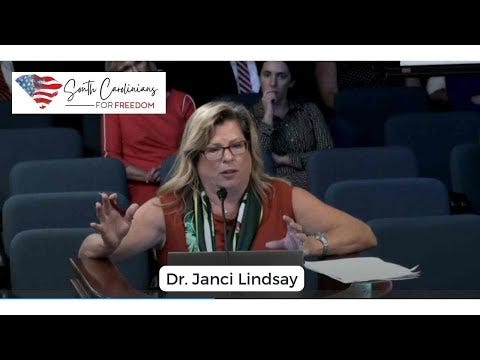Experience with Scheduling a State Hearing on Covid-19, the Hearing, and the Aftermath. Part 105
The SV40 Promoter Contraversy
Jessica Rose covered the presentation of Dr. Janci Lindsay at the SC PPLS Session on September 12. The video is in her substack or it can be accessed directly through YouTube.
The YouTube link is
At about the 5:20 mark in that video she discusses the SV40 Promoter.
Here is our commentary on this part of her presentation:
The ΨmRNA producing plasmid has a “promoter” in it.
A schematic of the plasmid highlighting the SV40 promoter is:
Some general scientific observations:
1. The promoter is NOT the entire SV40 virus genome. Relating this back to the polio virus and that carcinogenic event is not relevant to the argument that the dsDNA segments can be carcinogenic.
2. If the promoter is contained on a segment, then it will actively move the segment into the nucleus.
3. It will be as likely as any other segment to cause problems once it is incorporated into a chromosome.
The Palmer and Gilthorpe paper provides more detail:
(M. Palmer and J. Gilthorpe, "COVID-19 mRNA vaccines contain excessive quantities of bacterial DNA: evidence and implications," 05 04 2023. [Online]. Available: https://doctors4covidethics.org/covid-19-mrna-vaccines-contain-excessive-quantities-of-bacterial-dna-evidence-and-implications/. [Accessed 10 04 2023].)
Risks associated with SV40-derived regulatory DNA sequences
One feature that was identified by McKernan on Pfizer’s but not on Moderna’s expression plasmids [6] is a promoter derived from the SV40 virus, which belongs to the polyoma family (see Section 4.2).
The SV40 promoter also includes an internal origin of replication that can potentially cause copies of the plasmid to be made inside mammalian cells [21]. This will require the presence of the viral large T antigen, a protein which directly recognizes this origin and then initiates the replication of the DNA molecule. This protein is not encoded by the plasmid, nor is it normally present in our body cells, but it might be supplied by either the SV40 virus itself or by a related polyoma virus. A minority of the human population is latently infected with SV40, and such latent infection is associated with some malignant and non-malignant diseases [22]. Should a copy of the Pfizer plasmid be taken up into a cell harboring SV40, then additional copies of it might indeed be formed.
Two related polyoma viruses that are much more widespread in the human population are the BK and the JC virus [23,24]. The JC large T antigen is apparently less effective in conjunction with the SV40 origin than is SV40’s own protein [25], but the replication of Pfizer’s plasmid in cells latently infected with JC or BK viruses can nevertheless not be ruled out. Additional copies of the plasmid generated in this manner would amplify all of the other risks discussed in this section, with the possible exception of non-specific inflammation (see Section 4.4).
We agree with the rest of Dr. Lindsay’s presentation. We especially flag what has been know in our “normal” community here on substack that there was a change in manufacturing method between the trials and the mass production stage: the production stage used the bacterial production method; the experimental stage used “custom build” of the mRNA in vitro. We should consider the FDA and every certification organization in the world criminally negligent, at least, for not requiring a full GMP qualification with the correct quality specs for an mRNA vaccine (eg, 0 dsDNA).
We want to make clear, and credit Hedley Rees for his books and his constant attention to manufacturing practice, that GMP was not practiced and apparently still is not practiced in the manufacture of the countermeasure. As a manufacturing “expert” myself, I know that GMP is not going to happen if the contract and specifications aren’t explicit about manufacturing quality, not just by stating GMP must be observed, but by being explicit the quality bogies that must be met and the process for both achieving them and the process for shutting down the process when the bogies or process aren’t met (from development through shot in the arm- full life cycle, not just the “out the production manufacturing door”). That’s the way of business in the majority of facilities in the world.
For more detail on the contracts and lack of specifications and a quality focus, read Sasha Latypova’s substack.
Now that we’ve talked about the DNA issue, we have to say that, in terms of effectiveness and adverse effects, the psi-mRNA technology itself is, arguably, way more dangerous than the DNA issue. But if the DNA issue resonates with politicians and the public, then let’s go for it.





"2. If the promoter is contained on a segment, then it will actively move the segment into the nucleus."
Perhaps you mean the SV40 enhancer. This contains a 72bp sequence that supposedly binds with proteins native to the cell and the entire piece of DNA is actively transported to the nucleus and actively imported thru the nuclear pores. This means that a whole plasmid will be moved into the nucleus, or any smaller fragments that contain this SV40 enhancer sequence.
But the vast majority of this DNA contamination appears to be small fragments that can freely diffuse practically anywhere in the cell, including into the nucleus. This makes the "nuclear localization sequence" less interesting, because most of the DNA can get there anyway without it.
"3. It will be as likely as any other segment to cause problems once it is incorporated into a chromosome."
There is an argument that an insertion mutation containing a strong promoter element is worse than other random sequences, because it could create an open reading frame wherever it may insert, or just cause over-expression of a gene in whole or in part. But if the majority of the DNA contamination is around 50-200bp fragments, whole promoters won't typically remain intact, and therefore the simple disruption of normal genome sequence is the biggest hazard here.